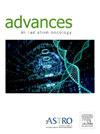Travel Burden of Radiation Therapy in the Philippines
IF 2.2
Q3 ONCOLOGY
引用次数: 0
Abstract
Purpose
Travel burden negatively impacts the stage at diagnosis, treatment, outcome, and quality of life among patients with cancer. Travel burden—quantified as distance, time, and cost of travel—is magnified in low- and middle-income countries like the Philippines, where radiation therapy (RT) resources are lacking and are inequitably distributed.
Methods and Materials
We compared Philippine Radiation Oncology Society data and the population census to determine the distribution and density of RT facilities across the country's 17 regions. For distance and travel time, we used the Google Maps route planner to determine the best routes from each province to the nearest private and government RT facility. Travel cost was calculated by multiplying distance by the local price of diesel per liter and the mean fuel economy of passenger vehicles in the Philippines.
Results
There are only 54 RT facilities in the Philippines (0.5 per 1 million population). More than a third are in the National Capital Region (NCR). Four regions do not have an RT facility. Nationally, the average distance to any RT facility is 101.02 km with a travel time of 2.66 hours and a travel cost of PHP 4811.11 ($85.91). Travel burden to any RT facility is the least in NCR and greatest in Visayas. Travel burden to a government RT facility is greater, with an average distance of 136.94 km, travel time of 3.05 hours, and travel cost of PHP 6353.43 ($113.45). Travel burden to a government RT facility is least in NCR and greatest in Mindanao.
Conclusions
The travel burden of RT in the Philippines is significant and varies regionally and by RT facility type (private or government). Data-driven installation of government RT facilities in underserved regions, alternative reimbursement systems to encourage hypofractionation when appropriate, patient subsidies for housing/transportation while on treatment, better public transportation, and patient navigation are needed.
菲律宾放射治疗的旅行负担。
目的:旅行负担对癌症患者的诊断、治疗阶段、预后和生活质量产生负面影响。旅行负担——以旅行距离、时间和费用来量化——在菲律宾等低收入和中等收入国家被放大,在这些国家,放射治疗(RT)资源缺乏且分配不公平。方法和材料:我们比较了菲律宾放射肿瘤学协会的数据和人口普查,以确定全国17个地区放射治疗设施的分布和密度。对于距离和旅行时间,我们使用谷歌Maps路线规划器来确定从每个省到最近的私人和政府RT设施的最佳路线。旅行费用的计算方法是将距离乘以当地每升柴油的价格和菲律宾乘用车的平均燃油经济性。结果:菲律宾只有54个RT设施(每100万人中有0.5个)。其中超过三分之一位于国家首都地区(NCR)。有四个地区没有RT设施。在全国范围内,到任何RT设施的平均距离为101.02公里,旅行时间为2.66小时,旅行费用为4811.11菲律宾比索(85.91美元)。到任何RT设施的旅行负担在NCR是最少的,在米沙鄢是最大的。到政府RT设施的旅行负担更大,平均距离为136.94公里,旅行时间为3.05小时,旅行费用为6353.43菲律宾比索(113.45美元)。到政府RT设施的旅行负担在NCR最少,在棉兰老岛最大。结论:菲律宾RT的旅行负担很大,并且因区域和RT设施类型(私人或政府)而异。需要在服务不足的地区以数据为导向安装政府RT设施,在适当情况下采用替代报销制度鼓励低分割,在治疗期间为患者提供住房/交通补贴,改善公共交通,并为患者导航。
本文章由计算机程序翻译,如有差异,请以英文原文为准。
求助全文
约1分钟内获得全文
求助全文
来源期刊

Advances in Radiation Oncology
Medicine-Radiology, Nuclear Medicine and Imaging
CiteScore
4.60
自引率
4.30%
发文量
208
审稿时长
98 days
期刊介绍:
The purpose of Advances is to provide information for clinicians who use radiation therapy by publishing: Clinical trial reports and reanalyses. Basic science original reports. Manuscripts examining health services research, comparative and cost effectiveness research, and systematic reviews. Case reports documenting unusual problems and solutions. High quality multi and single institutional series, as well as other novel retrospective hypothesis generating series. Timely critical reviews on important topics in radiation oncology, such as side effects. Articles reporting the natural history of disease and patterns of failure, particularly as they relate to treatment volume delineation. Articles on safety and quality in radiation therapy. Essays on clinical experience. Articles on practice transformation in radiation oncology, in particular: Aspects of health policy that may impact the future practice of radiation oncology. How information technology, such as data analytics and systems innovations, will change radiation oncology practice. Articles on imaging as they relate to radiation therapy treatment.
 求助内容:
求助内容: 应助结果提醒方式:
应助结果提醒方式:


